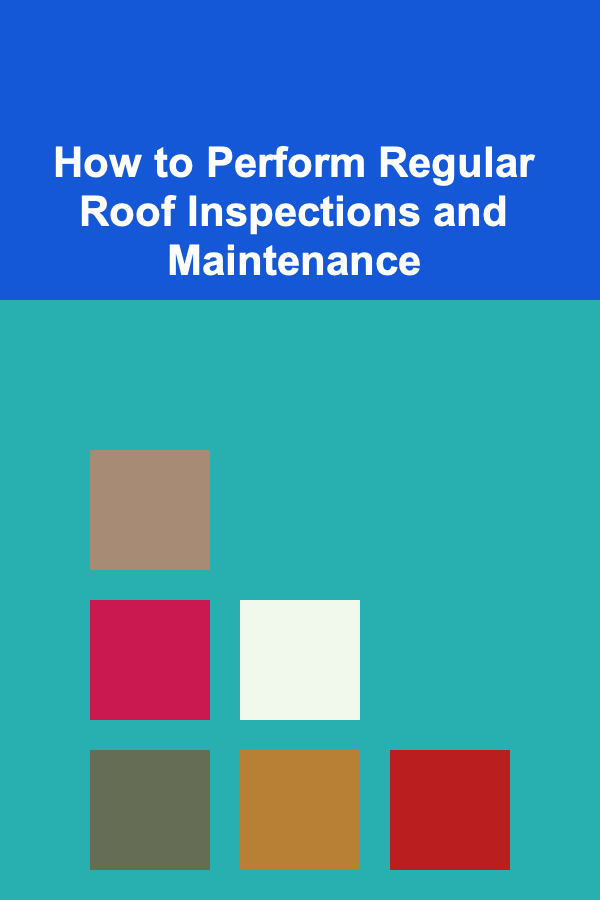
How to Clean Your Air Conditioner Filter
ebook include PDF & Audio bundle (Micro Guide)
$12.99$8.99
Limited Time Offer! Order within the next:

Air conditioning units are essential in many homes, providing cool air during hot weather and maintaining indoor comfort. However, without proper maintenance, your air conditioner may not function efficiently, leading to higher energy bills and poor air quality. One of the simplest and most important tasks you can perform to keep your air conditioner in top shape is cleaning the air filter. In this article, we'll delve into why it is necessary to clean your air conditioner filter, how to do it step-by-step, and the impact this maintenance has on the overall performance of your system.
Why Cleaning Your Air Conditioner Filter Is Important
Before jumping into the cleaning process, it's important to understand why you should clean your air conditioner filter regularly. An air conditioner filter plays a crucial role in maintaining the performance and health of your air conditioning system, as well as ensuring the quality of the air you breathe. Here are several reasons why regular filter cleaning is essential:
1. Improved Airflow and Efficiency
The primary function of an air filter is to trap dust, dirt, pollen, and other airborne particles that could clog the system. Over time, as the filter accumulates debris, it becomes clogged, restricting airflow. When airflow is reduced, your air conditioner must work harder to maintain the desired temperature, which leads to increased energy consumption and a strain on the system.
By cleaning or replacing the filter, you restore optimal airflow, allowing your air conditioner to run more efficiently. This leads to energy savings and prolongs the life of your unit.
2. Enhanced Indoor Air Quality
Filters are also designed to trap allergens, dust, and other harmful particles. A dirty or clogged filter cannot effectively perform this task, which can result in poor indoor air quality. For individuals with respiratory conditions such as asthma or allergies, this can be particularly problematic.
Cleaning the filter ensures that your air conditioner continues to clean the air you breathe, removing harmful particles and improving indoor air quality.
3. Prevention of System Damage
Over time, a dirty filter can lead to larger problems within your air conditioning system. When airflow is restricted, the evaporator coil can freeze, or the system may overheat. These issues can lead to costly repairs or even complete system failure. Regular cleaning of the filter helps avoid these complications and keeps your system running smoothly.
4. Extended Lifespan of the Air Conditioner
Routine maintenance, including cleaning the filter, helps to extend the life of your air conditioning unit. The less stress the system experiences, the longer it will last. Regular filter cleaning can save you money in the long run by preventing costly repairs and extending the life of your air conditioner.
How Often Should You Clean Your Air Conditioner Filter?
The frequency of cleaning your air conditioner filter depends on several factors, including the type of filter, how often the unit is used, and the environment in which it operates. Here are some general guidelines:
- Standard Air Filters: These should be cleaned or replaced every 1 to 3 months, depending on usage.
- High-Efficiency Filters: These may need cleaning every 6 months or so, but this can vary based on the specific model and manufacturer recommendations.
- Environmental Factors: If you live in a particularly dusty area, have pets, or use your air conditioner frequently, the filter may need to be cleaned more often. For example, if you have pets, you may want to clean the filter every month due to the pet hair and dander that can accumulate.
If you notice reduced airflow or hear unusual noises from the air conditioner, these could be signs that the filter is clogged and in need of cleaning.
Tools You Will Need to Clean the Air Conditioner Filter
Cleaning an air conditioner filter is a relatively simple task that requires only a few basic tools. Here's a list of items you'll need to clean your filter:
- Vacuum cleaner with a soft brush attachment: For light cleaning and to remove loose dust.
- Warm water: For soaking and cleaning the filter.
- Mild soap or detergent: To clean the filter thoroughly.
- Soft cloth or sponge: For wiping down the filter after it has been soaked.
- Bucket or basin: To soak the filter in warm water.
- Screwdriver (if applicable): For removing the air filter from the unit.
In some cases, a wet-dry vacuum may be used for deep cleaning, especially if the filter is heavily clogged with dirt and debris.
Step-by-Step Guide to Cleaning Your Air Conditioner Filter
Now that you understand why cleaning the air filter is essential and have the necessary tools, here's a step-by-step guide on how to clean your air conditioner filter:
1. Turn Off the Power
Before starting any cleaning process, make sure to turn off the air conditioner and disconnect it from the power supply. This will ensure your safety and prevent any accidental damage to the system while cleaning.
2. Locate the Air Filter
The location of the air filter depends on the type of air conditioning system you have. In most cases, the filter is located near the return air vent, which is usually on the front or side of the air conditioner. Some units may have the filter located behind a grille or cover, which may require you to remove screws or clips to access it.
If you are unsure about where the filter is located, consult the owner's manual for guidance.
3. Remove the Air Filter
Once you've located the filter, carefully remove it from its slot. Some filters may be easily pulled out, while others may require a screwdriver to remove a panel or cover. Be gentle when handling the filter to avoid damaging it.
4. Inspect the Filter
Before cleaning, take a moment to inspect the filter for any visible damage. If the filter is torn or excessively worn, it may need to be replaced rather than cleaned. If the filter is in good condition, you can proceed with cleaning.
5. Vacuum the Filter
Using a vacuum cleaner with a soft brush attachment, gently vacuum the surface of the filter to remove any loose dust, dirt, and debris. This step will help prevent larger particles from clogging the filter during the cleaning process.
6. Soak the Filter
Next, soak the filter in a basin or bucket filled with warm water and mild soap or detergent. Allow the filter to sit for 15 to 20 minutes. This will help loosen any stuck debris and grime that may not be easily removed by vacuuming alone.
7. Scrub the Filter
After soaking, use a soft cloth or sponge to gently scrub both sides of the filter. Pay attention to any particularly dirty areas and scrub gently to avoid damaging the filter material. Be sure to clean the filter thoroughly but avoid using harsh chemicals or abrasive tools that could damage the filter.
8. Rinse the Filter
Once the filter is clean, rinse it thoroughly with warm water to remove any soap residue. It's important to ensure that all detergent is removed to prevent it from being blown into the air when the air conditioner is turned back on.
9. Dry the Filter
After rinsing the filter, gently shake off any excess water and allow the filter to air dry completely. Avoid using a hairdryer or direct heat source to speed up the drying process, as this could damage the filter material. It's essential that the filter is completely dry before reattaching it to the unit.
10. Reinstall the Filter
Once the filter is completely dry, carefully reinstall it into the air conditioner unit. Ensure that it is securely positioned in its designated slot and that any panels or covers are properly reattached. Turn the power back on and test the air conditioner to ensure that it is working efficiently.
Tips for Maintaining Your Air Conditioner Filter
While cleaning the filter regularly is crucial, there are a few additional tips to help maintain your air conditioner and its filter:
1. Check the Filter Monthly
Even if you're not cleaning the filter every month, it's a good idea to check the filter for buildup. If you notice significant dust accumulation, clean it sooner than planned.
2. Replace the Filter as Needed
Air filters have a finite lifespan, and some types are not designed for multiple cleanings. If your filter appears damaged or overly dirty, replace it with a new one. Many filters are designed to be replaced every 1 to 3 months, so be sure to follow the manufacturer's recommendations.
3. Consider Upgrading Your Filter
If you want to improve air quality further, consider upgrading to a higher-efficiency air filter, such as a HEPA filter or one with a higher MERV (Minimum Efficiency Reporting Value) rating. These filters are designed to capture smaller particles, offering better filtration for dust, allergens, and pollutants.
4. Keep the Area Around the Unit Clean
To reduce the frequency of cleaning, make sure the area around the air conditioner is free from dust and debris. Regularly dust the vents and clean the area where the unit is placed. This will reduce the amount of dirt that enters the filter and help maintain better airflow.
5. Professional Maintenance
While cleaning the filter is a simple task, it's also important to have your air conditioner professionally serviced at least once a year. A technician can inspect the system for any issues, clean the coils, and ensure that everything is functioning optimally.
Conclusion
Cleaning your air conditioner filter is one of the easiest and most effective ways to ensure that your air conditioning unit runs efficiently and keeps your indoor air quality high. Regular maintenance, including cleaning the filter, helps prevent system damage, reduces energy consumption, and prolongs the life of your unit. By following the steps outlined in this article, you can keep your air conditioner in top condition and enjoy a cooler, healthier living environment.

How to Organize Your Pot and Pan Lids in a Drawer
Read More
How to Perform Regular Roof Inspections and Maintenance
Read More
How to Soundproof Your Basement for a Home Gym
Read More
How to Store Your Shoes Without Taking Up Too Much Room
Read More
How to Use Customer Support Software to Make Money
Read More
How to Build a Minimum Viable Product (MVP) Quickly
Read MoreOther Products

How to Organize Your Pot and Pan Lids in a Drawer
Read More
How to Perform Regular Roof Inspections and Maintenance
Read More
How to Soundproof Your Basement for a Home Gym
Read More
How to Store Your Shoes Without Taking Up Too Much Room
Read More
How to Use Customer Support Software to Make Money
Read More